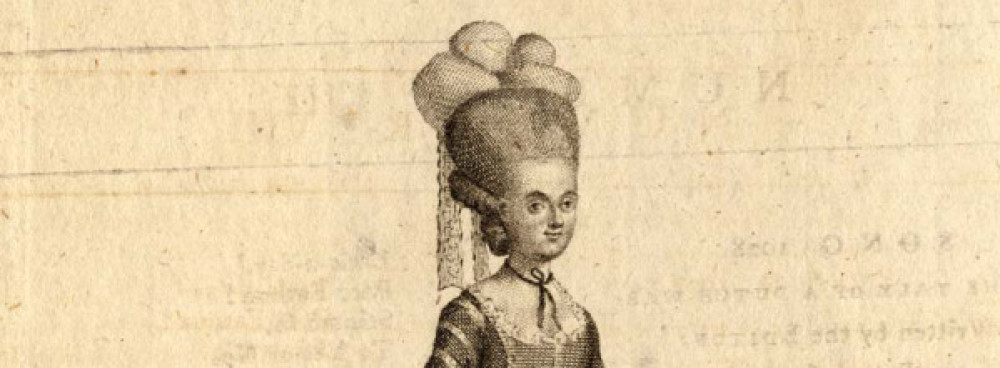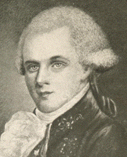
Lewis Hallam Jr., public domain, courtesy of WikiCommons
Eliza Hallam, originally Eliza Tuke, joined the Old American company sometime around 1787 following the death of her sister, Sarah Tuke who was the first Miss Tuke to perform in the company, where she met a Mr. Lewis Hallam Jr.[i] They would go on to marry in January 1793 following the death of Mr. Hallam’s first wife, Sarah Perry Hallam: “The Philadelphia Daily Advertiser of 17 January 1793 reported the marriage of Lewis Hallam to the beautiful young actress Eliza Tuke, with whom he had lived for some time.”[ii] While she was known as Miss Tuke, she was written off as an actress, but after marrying Mr. Hallam, Eliza’s talents as a comic actress grew through the remainder of the decade, “She was the first American actress who attained celebrity and this she owed to the assiduous attentions of her husband, whose instructions raised her from comparative worthlessness to a high station in the theatre.”[iii]
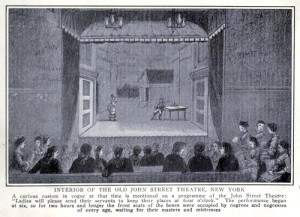
John Street Theatre, public domain, WikiCommons
Starting out in smaller roles, Miss Tuke was known as an excruciatingly terrible actress, as exemplified in a critique of an early performance in the play She Stoops to Conquer in 1791: “Miss Tuke as Miss Neville was less tenderly treated. Nothing, the critic said, appeared to move her—not even unexpectedly meeting with her lover.”[iv] Yet, after her marriage to Mr. Hallam in 1793, it appears that she began to excel as a proficient actress in larger roles. One such example is seen in a critique published a few days following her performance as Marianne in The Dramatist in January of 1793: “It would be doing injustice to Mrs. Hallam, not to notice her improvement; she seems to be acquiring rapidly that ease and vivacity on the stage, which is all that is wanting to make a pleasing performer.”[v] Unfortunately, Mrs. Hallam’s rise to the top as an actress merely prefaced her eventual descent into drug and alcohol abuse, which effected her public image.
By the latter half of the decade, Mrs. Hallam had begun an addiction with drugs and alcohol, eventually leading to her withdrawal from the stage for some time:
“It was about this time,” says Dunlap, that Mrs. Hallam “was withdrawn from the stage, in consequence of an unfavourable impression made upon the audience by her appearance in the principal lady’s character in . . . the Jew. Mr. Hallam attributed the very strange exhibition to opium. The audience were shocked and disgusted. The actress was withdrawn from the public eye. Discontent ensued.” [vi]
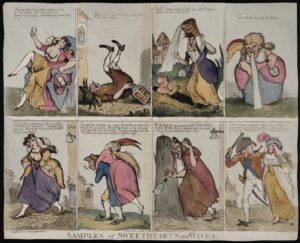
“Samples of Sweethearts and Wives” by Richard Newton, 1795 via Slate.com.
The cause of this addiction was in part due to “the deterioration of her public popularity” as well as Mr. Hallam’s temperament and character, as he “was a man of irascible humor and old enough to be her father.”[vii] These addictions led to quarrels within the company, predominately between the Hallams and Hodgkinsons.
The beginning of controversies amongst the Hallams and Hodgkinsons came around January 5th of 1795 where Eliza Hallam performed as Birtha in Percy (Harbin, 218). During this performance John Hodgkinson accidentally cut Lewis Hallam in a fight scene, sending Eliza onto the stage in “a violent passion”: “ ‘Why, That damn’d Butcher has cut Mr. Hallam!’ (Hodgkinson, p.7)”[viii] Hodgkinson left the theatre and quarrels between the Hallams and Hodgkinsons ensued, fueled by Mrs. Hallam’s increasingly tumultuous behavior.
It was in February that Mrs. Hallam performed under the influence as Eliza in The Jew: “the audience witnessed an Exhibition too disgustful to remember, and too disgraceful to the stage to be dwelt upon’ (Hodgkinson, p. 8)”[ix] This exhibition of Mrs. Hallam’s allowed Hodgkinson to force her into withdrawal from the stage. From then on Eliza entered a pattern of return and withdrawal upon the stage, going weeks at a time without work. But following her continuous pleads with Hodgkinson and the managers of the company, she returned to the stage in 1797 with the sole purpose of calling out John Hodgkinson:
“On March 29th, when, during a performance of The Fashionable Lover, the embattled Mrs. Hallam walked out on the stage and prepared to address the audience… [she] had not been permitted to act at all–by Hodgkinson… because of her excessive drinking and general trouble-making…She entered from the right,” reports Dunlap, “dressed in black silk, her hair parted on the top of her head, combed down on each side of her face, and powdered. She looked beauty in distress. She held a paper in her hands, and courtesied most profoundly.”[x]
Mr. Hallam entered opposite Mrs. Hallam and together they pleaded with the audience for Eliza’s return to the stage. The audience villanized Mr. Hodgkinson following this public display of disdain, and Eliza was able to return the following May as Lady Teazle in School for Scandal, where she read a prologue by Milns [sic]:
“These flattering plaudits cannot fail to raise
A wish to merit such transcendent praise;
It can but be a wish,
For Ah!—my heart Knows merit could not claim a thousandth part: Bu t like the lavish hand of Heaven, you Give largely e’en though nothing should be due. O’ercome with joy, my anxious throbbing heart,
Disdaining all the little tricks of art,
Conceals those feelings in a grateful breast
Which may be felt, but cannot be express’s.
Time has now swept ten rolling years away,
Since flattering plaudits graced my first essay,*
Young, giddy, rash, ambitious, and untaught,
You still caress’d, excusing many a fault;
With friendly hand safe led me through the way
Where lurking error watches to betray:
And shall I such advantages forego With my consent? I frankly answer, No: I may through inadvertency have stray’d, But who by folly never was betray’d?
If e’er my judgment played the foolish part, I acted not in concert with my heart. I boldly can defy the world to say From my first entrée to the present day,
Whate’er my errors, numerous or few, I never wanted gratitude to you. On your indulgence still I’ll rest my cause; Will you support me with your kind applause?
You verify the truth of Pope’s fine line— ‘To err is human; to forgive, divine.’”[xi]
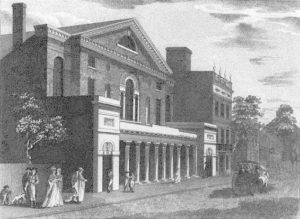
Old Chestnut Street Theatre
Following these arguments with the Hodgkinsons, as well as other performers in the theatre, continued withdrawal from the stage, and loss of popularity among the public, Lewis and Eliza decided to leave the Old American Company to pursue openings in the Philadelphia Company in 1806. By the end of 1808, Mr. Hallam had died and was buried in an unmarked grave in Philadelphia. It is presumed that Eliza did not continue to act without her husband, and it is estimated she passed away by or around 1817, for her son, William Hallam, came to New York to sell their home on John Street and settle his father’s past affairs. The whereabouts of her death and grave are unknown. [xii]
NOTES:
[i] Robert J. Myers, and Joyce Brodowski. “Rewriting the Hallams: Research in 18th Century British and American Theatre.” Theatre Survey TSY 41.01 (2000): 12. Print.
[ii] Philip H. Highfill, Kalman A. Burnim, and Edward A. Langhans. A Biographical Dictionary of Actors, Actresses, Musicians, Dancers, Managers & Other Stage Personnel in London,1660-1800.Carbondale: Southern Illinois University Press, 1973. Print.
[iii] Joseph Norton Ireland. Records of the New York Stage from 1750 to 1860. New York: B. Blom, 1966. Print.
[iv] George Oberkirsh Seilhamer. History of the American Theatre. New York: Haskell House, 1969. 326. Print.
[v] George Clinton Densmore O’Dell, and Princeton University. Annals of the New York Stage. New York: Columbia University Press, 1927. 317. Print.
[vi] Glenn Hughes. A History of the American Theatre, 1700-1950.New York: S. French, 1951. 384. Print.
[vii] Billy J. Harbin. “The Role of Mrs. Hallam in the Hodgkinson-Hallam Controversy: 1794-1797.” Theatre Journal 32.2 (1980): 213-22. Web.
[viii] Harbin, 218.
[ix] Harbin, 218.
[x] Hughes, 77.
[xi] William Dunlap, and Dorothy C. Barck. Diary of William Dunlap, 1766-1839: The Memoirs of a Dramatist, Theatrical Manager, Painter, Critic, Novelist, and Historian.New York: B.Blom, 1969. Print. Collections of the New York Historical Society for the year 1929-31,62-64; Collections of the New-York Historical Society for the year … (1868), v. 62, etc.
[xii] Myers, 15-16.
By: Drew Smith
